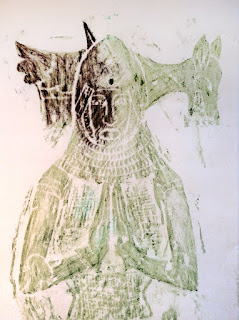Researching the work of other artists... Scientific Drawing.
For a City & Guilds in 'Creative Techniques; Drawing and Painting', I must review the work of other artists. One new, one old - a contemporary artists and an old master. Here I am going to take a very quick look at two scientific artists.
I have always loved the coming together of Art and Science, so my choice for a contemporary artist in the UK has to be this one: Katrina van Grouw. She was the curator for the Natural History Museum collections, not in Kensington, London, where the museum itself is situated, but in Buckinghamshire where the great stores of collections are kept. What a great job to have had!
I was very fortunate. Katrina came to Norwich Castle Museum to give a talk about her work as part of an exhibition "The Wonder of Birds" in 2014. I bought a copy of her book, of course.
Here is a link to the Exhibition from the Norfolk Museums Service: The Wonder of Birds.
And, here is a link to a website for Katrina van Grouw's book: The Unfeathered Bird.
Her book is a beautiful book. The illustrations are reproduced very carefully onto coloured paper. I believe the original drawings were produced on typical white paper but she chose to have them reproduced in this new colour tint to give an antique appearance. In fact, she explained the publisher found it easier to have the sheets printed with a background colour first, before the final printing, rather than to use a coloured paper. The authentic colour would be graphite on white, but not so easy on the eye as the sepia tint, an extra expense in the publishing that I think must have been well worth it.
Katrina when to great lengths to explain how she prepared her skeletons for drawing. Each drawing is produced from a real specimen, each one carefully prepared by herself in a long process of de-fleshing and cleaning the bones before reassembling them into a life-like pose. A lot of work - and not to everyone's pleasure! Few people want to have stewing bones strewn around their house!!!
There is, of course, one other scientific ornithological artist, world renowned, who also worked in another era, directly from collected specimens, each one posed in a life-like position for the purpose of a drawing; John James Audubon, (1785 - 1851).
Audubon was the first person to make a systematic survey of all the birds, and later all the mammals, of North America, reproducing each one, in a life-size, life-like pose in a book of 435 water-coloured drawings. His preparation may not have been quite so careful as Katrina van Grouw's. Audubon used specimens he shot himself, mounted onto wires to hold their position. These lasted only just long enough to produce the drawings before decomposition set in. Katrina's skeletal specimens are mounted and preserved.
Each drawing may then have been reproduced in a great folio, as a hand-coloured lithograph. Accuracy and clarity were of great importance in this type of drawing, so, Audubon's use of naturalistic poses and backgrounds is also rather ground-breaking for a scientific taxonomic work.
Audubon's illustrations can be seen here: Birds of America.

















































